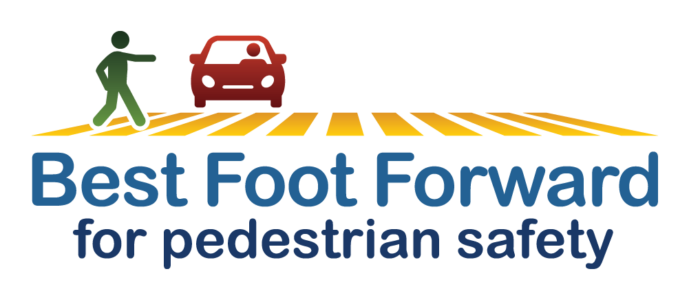In recognition of School Crossing Guard Appreciation Day on February 7, the Best Foot Forward…
Educating Drivers and Walkers about New Pedestrian Hybrid Beacons
Over the years, local governments and the Florida Department of Transportation (FDOT) have worked to make South Orange Blossom Trail (OBT) safer for people on foot. They’ve installed medians, placed bus shelters along the roadway and widened sidewalks in some places. But the fact remains that South OBT is a busy place. It’s a six lane U.S. Highway, and traffic is heavy. FDOT’s latest average daily traffic count shows more than 58,000 vehicles a day use the section of OBT that extends from Holden Avenue to Interstate 4 (I-4).
Between 2015 and 2019, there were 28 crashes between I-4 and Holden Avenue involving pedestrians crossing South OBT. In those 28 crashes, 10 people lost their lives.
Three mid-block crossings existed in this area already, but those who chose to use them rolled the dice and took their chances. Their odds were little better than if they had crossed at any random point along this stretch. In fact, in 2016, Best Foot Forward data collectors measured that only about three of every 100 drivers were yielding to people trying to cross at the marked crosswalk on OBT, north of Holden Ave. Drivers were not yielding for people using the mid-block crosswalks – and they still don’t.
Now FDOT is trying something new to increase safety. It has upgraded the three mid-block crossings to crossings with pedestrian hybrid beacons (PHBs). These triangular traffic signals now mark the following locations on South OBT:
- on the south side of 37th, between a car sales business and a pawn shop
- between 44th and 42nd St., between a Chevron gas station and a motel
- 900 feet north of Holden Ave., between Walgreens and the Southgate Shopping Center
The pedestrian hybrid beacons – sometimes called high intensity activated crosswalks or HAWKs – are designed to help pedestrians cross the road safely while maximizing traffic flow. They act as a traffic signal of sorts, with a solid red light to make traffic stop for people trying to get across. But the length of the red light is not as long-lasting as a traffic signal at a busy intersection. It allows enough time for the pedestrian to cross without causing major traffic back-ups.

How does it work for pedestrians?
When a pedestrian reaches the crosswalk, the PHB will display a solid “don’t walk” hand, like other crosswalks. The user presses the button, and the PHB goes through its sequencing to stop traffic. Once activated, the solid red hand will change to a walk sign.
Even though the sign indicates it’s their turn to cross, pedestrians should still always check for oncoming cars. Like a regular crosswalk, pedestrians should finish crossing when the walk sign becomes a flashing red hand. The signal will remain on “don’t walk” until another person activates the button again.
For drivers?
For drivers, the signal begins and ends its cycle completely dark. When a pedestrian presses the button, the triangular signal will start flashing yellow, followed by a solid yellow. This tells drivers they must prepare to stop. Next, drivers will see a solid red light, which means drivers must stop.
After a while, the signal will flash, alternating between two red lights. Drivers may proceed if the pedestrian is no longer in the crosswalk. All drivers should treat the flashing red lights like a stop sign, pulling up to the bar and stopping completely, checking that the intersection is clear, and then continuing through the intersection.
When the signal goes dark again, drivers can continue through the intersection until it is activated by the next pedestrian.

Cities throughout the country are beginning to implement new technology like the pedestrian hybrid beacons. With them, the hope is to keep more pedestrians safe and increase their confidence in using marked crosswalks while maintaining efficiency for drivers.
The key here is buy-in and education. Drivers must obey the lights, and pedestrians need to use the crosswalks. All transportation users will benefit learning more about pedestrian hybrid beacons. These videos are a good place to start: New Pedestrian Safety Signals and Understanding The Pedestrian Hybrid Beacon.




This Post Has 0 Comments